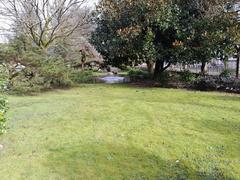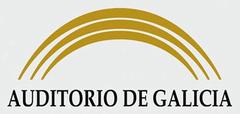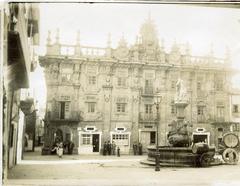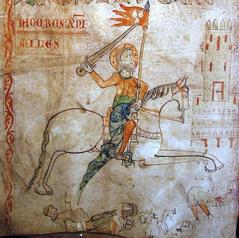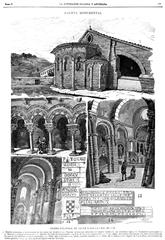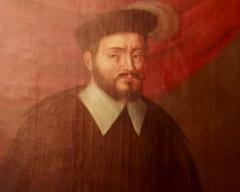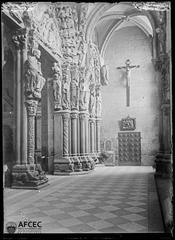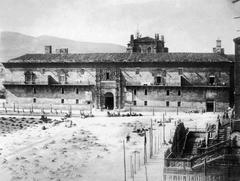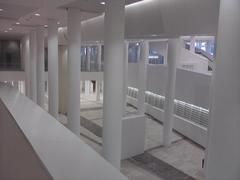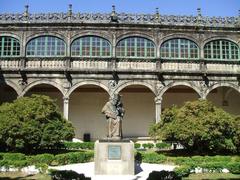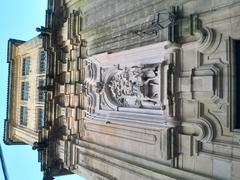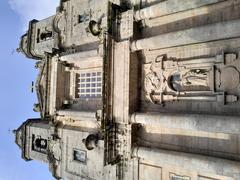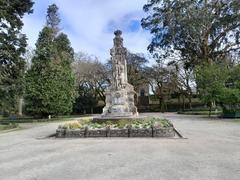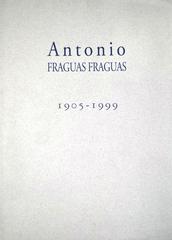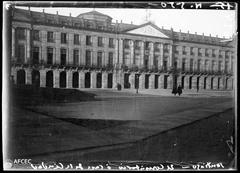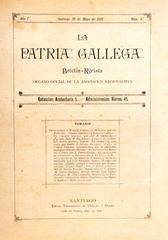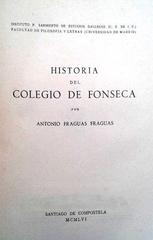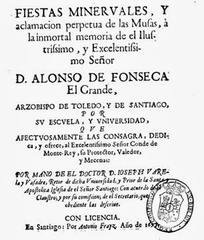Pilgrim’s Reception Office Santiago de Compostela: Visiting Hours, Tickets, and Essential Tips
Date: 03/07/2025
Introduction
The Pilgrim’s Reception Office in Santiago de Compostela stands as a cornerstone of the Camino de Santiago pilgrimage—a vibrant tradition dating back to the 9th century. Serving as the official gateway for pilgrims who reach the city, the office is both a historic symbol of hospitality and a modern hub for those concluding their spiritual, cultural, or personal journey. Here, pilgrims receive the esteemed Compostela certificate—a testament to their achievement—after presenting proof of their pilgrimage along the Camino’s storied routes (Santiago Cathedral; Walk the Camino).
Strategically located near the iconic Plaza del Obradoiro and the Cathedral of Santiago de Compostela, the office provides a welcoming environment, with free entry and services designed for accessibility. Its role extends beyond administration: it is a place of cultural exchange, reflection, and support, embodying the values that have defined the Camino for centuries. This comprehensive guide details everything you need to know for a smooth and meaningful visit—from location and opening hours to certification requirements, travel tips, and nearby attractions (Caminodesantiago.gal).
Contents
- Origins and Evolution of the Pilgrim’s Reception Office
- Religious and Cultural Significance
- Location, Visiting Hours, and Accessibility
- The Compostela Certificate: Requirements and Process
- Pilgrim Passport (Credencial): Purpose and Use
- Step-by-Step Guide: Collecting Your Compostela
- Practical Travel Tips
- Nearby Historical Sites and Attractions
- Visitor Services and Facilities
- Managing Crowds and Responsible Tourism
- FAQs
- Official Sources and Further Reading
Origins and Evolution of the Pilgrim’s Reception Office
The history of the Pilgrim’s Reception Office is deeply intertwined with the growth of the Camino de Santiago itself. Following the discovery of Saint James’s remains in the 9th century, Santiago de Compostela became one of Christianity’s most important pilgrimage destinations, necessitating the development of infrastructure to support and document the journeys of countless pilgrims. Early forms of hospitality were offered by religious institutions and medieval hostels, later formalizing into the modern office that registers pilgrims and issues the revered Compostela certificate (Santiago Cathedral).
The office’s role has evolved over time, adapting to fluctuations in the popularity of the pilgrimage and the changing needs of travelers. Today, it is not only an administrative center but also a cultural and spiritual touchstone, ensuring the authenticity and continuity of the Camino tradition.
Religious and Cultural Significance
The Pilgrim’s Reception Office is more than an endpoint; it is a symbol of the Camino’s enduring spiritual and communal values. The Compostela certificate—issued exclusively by this institution—serves as a tangible acknowledgment of the journey’s physical and spiritual dimensions. Pilgrims must present the “credencial” (pilgrim passport) with the required stamps to prove completion of at least the final 100 km on foot or horseback, or 200 km by bicycle (Walk the Camino). This process preserves the integrity of the pilgrimage and honors its centuries-old traditions.
Location, Visiting Hours, and Accessibility
Location
- Address: Rúa Carretas, 33, 15705 Santiago de Compostela, A Coruña, Spain
- Proximity: Just steps from the Plaza del Obradoiro and the Cathedral’s main entrance, with clear signage throughout the city (Caminodesantiago.gal).
Visiting Hours
- High Season (May 1–October 15): 09:00–21:00 daily
- Low Season (October 16–April 30, except Easter):
- Monday–Saturday: 10:00–20:00
- Sunday: 10:00–14:00 and 16:00–20:00
- Easter and Special Dates: Hours may vary; always check the official website for up-to-date information.
- Closed: December 25 (Christmas) and January 1 (New Year’s Day); on these days, certificates can be collected at the Cathedral’s sacristy.
Accessibility
The office is fully accessible, featuring ramps, elevators, wide corridors, and accessible restrooms. Assistance is available for visitors with disabilities. Contact the office in advance if you require special accommodations (El Camino The Way).
The Compostela Certificate: Requirements and Process
Historical and Spiritual Meaning
The Compostela certificate is the official document recognizing the completion of the Camino de Santiago. Traditionally written in Latin and personalized with the pilgrim’s name and arrival date, it reflects the physical and spiritual journey undertaken (americanpilgrims.org).
Eligibility Criteria
- Minimum Distance: 100 km on foot/horseback or 200 km by bicycle
- Motivation: Spiritual, religious, or at least searching reasons (not solely for tourism or sport)
- Credencial: Present a pilgrim passport with at least two stamps per day for the last qualifying kilometers (caminoways.com)
- Verification: Staff will check your stamps and may ask brief questions about your journey
Additional Certificates
- Certificate of Distance: Details your starting point, route, and total kilometers (available for a small fee)
- Finisterrana/Muxiana: For those who continue to Finisterre or Muxía, special certificates are available at those destinations (caminoways.com).
Pilgrim Passport (Credencial): Purpose and Use
Purpose
The Pilgrim Passport is essential for:
- Proof of Pilgrimage: Required for staying in most albergues and obtaining the Compostela
- Stamp Collection: Demonstrates your journey and serves as a cherished memento
- Access to Services: Some discounts and services are exclusive to credentialed pilgrims (caminoadventures.com)
Where to Obtain
- International Associations: American Pilgrims on the Camino, Camino Society of Ireland, etc.
- In Spain: Churches, cathedrals, tourist offices, and select hostels
- Online: Many organizations offer mail delivery (americanpilgrims.org)
Stamping
Collect at least two stamps per day in the final 100 km (or 200 km for cyclists) from churches, albergues, town halls, and cafés (caminoways.com).
Step-by-Step Guide: Collecting Your Compostela
- Prepare Your Documents: Ensure your credencial is stamped and complete.
- Arrive at the Office: Visit during off-peak hours (early morning or late afternoon) to avoid long waits.
- Queue Management: Register online or at the office (via QR code) to receive a ticket with real-time wait tracking (oficinadelperegrino.com).
- Verification: Present your credencial and answer any questions from staff.
- Receive Your Certificate: The Compostela is free. A Certificate of Distance can be purchased for a nominal fee.
- Protect Your Certificate: Purchase a cardboard tube (available at the office or local shops) to safeguard your documents.
Practical Travel Tips
- Luggage: Backpacks are not allowed inside the Cathedral due to security; use commercial luggage storage nearby (Walk the Camino Portugues).
- Transport: The office is within walking distance of the cathedral, bus, and train stations. Taxis are available; cycling pilgrims can use dedicated parking and services.
- Accommodation: The office staff can advise on local hostels, hotels, and albergues.
- Waiting Times: During peak seasons and Holy Years, expect longer waits; plan accordingly if attending the Pilgrim Mass or other events.
- COVID-19 Measures: Follow current health guidelines (check the official website for updates).
Nearby Historical Sites and Attractions
After completing your administrative formalities, explore Santiago’s historic gems:
- Cathedral of Santiago de Compostela: The spiritual heart of the pilgrimage and a UNESCO World Heritage Site.
- Praza do Obradoiro: The city’s main square with iconic views.
- Monastery of San Martín Pinario: A grand historic monastery and cultural site.
- Museo do Pobo Galego: Showcasing Galician culture and history.
- Old Town: Wander picturesque streets lined with traditional shops and cafés (Santiago de Compostela historical sites).
Visitor Services and Facilities
- Information: Multilingual staff provide orientation and assistance.
- Restrooms: Modern, accessible facilities.
- Chapel: Space for reflection and prayer.
- Wi-Fi & Charging: Free internet and charging stations available.
- Bicycle Services: Parking and returns for rented bicycles.
- Social Support: Welfare and rehabilitation services for recovering pilgrims.
Managing Crowds and Responsible Tourism
With over 446,000 pilgrims in 2023, Santiago faces overtourism challenges (NSS Magazine). Pilgrims are urged to respect local customs, minimize noise, support local businesses, and reduce environmental impact to help preserve the city’s unique character and heritage.
Frequently Asked Questions (FAQs)
Q: What are the opening hours of the Pilgrim’s Reception Office?
A: Varies by season—see above; closed December 25 and January 1.
Q: Is there a fee for the Compostela?
A: No, the Compostela is free of charge.
Q: What documents do I need?
A: A stamped Pilgrim Passport (credencial) covering the minimum distance.
Q: Is the office accessible?
A: Yes, the office is fully accessible; contact in advance for special needs.
Q: Can I collect my Compostela the same day I arrive?
A: Not always during peak times; same-day collection cannot be guaranteed.
Official Sources and Further Reading
- Santiago Cathedral – Pilgrimage Information
- Pilgrim’s Reception Office – Official Info
- Compostela Certificate Guide – Caminoways.com
- Oficina del Peregrino – Certificate Information
- Walk the Camino – Pilgrim Office Guide
Conclusion
The Pilgrim’s Reception Office in Santiago de Compostela is not just an administrative checkpoint—it is the heart of a living tradition that welcomes every pilgrim at journey’s end. Here, you receive more than a certificate; you become part of an enduring cultural and spiritual legacy. Plan your visit with these tips, explore the city’s historical treasures, and embrace the communal spirit of the Camino de Santiago.
For real-time updates, maps, and further details, visit the official website. Download the Audiala app for personalized guidance and queue updates, and follow us on social media for the latest news and tips.
Buen Camino!
